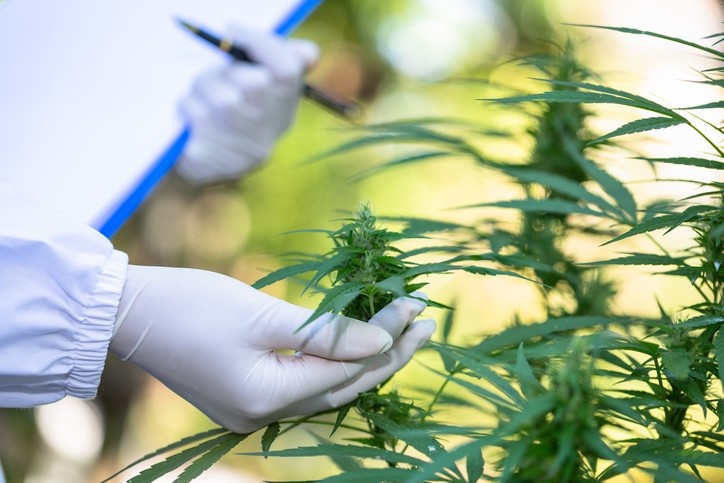Special Edition: Cannabis beauty - Innovation and science in CBD and cannabinoids
Beyond CBD? Any of the 100+ minor cannabinoids could be a ‘rock star’ beauty active, says Treehouse Biotech

In recent years, interest in cannabinoids found in the Cannabis Sativa L plant, or hemp, had soared in topical beauty products. And cannabidiol (CBD) in particular had taken the spotlight as the ‘golden’ ingredient in this burgeoning space. But as science and innovation advanced, parts of industry had started to look beyond this star ingredient to the 100+ other cannabinoids available in the plant.
Beyond CBD? ‘Minor cannabinoids’ is where ‘the most potential lies’
“I think these minor cannabinoids, these 100-plus other molecules of which no-one knows anything about for the most part, I think they have really great potential,” said Jake Black PhD, co-founder and chief science officer of Treehouse Biotech – recently acquired by Next Frontier Brands.
“I always use this as an example to explain why: the difference between THC [Tetrahydrocannabinol] and CBD, molecularly, is one single bond. Other than that, they’re completely identical. But that single bond changes the molecule shape and it has very different effects. You can eat 100mg of CBD and you’re not going to have any effect; you eat 100mg of THC and there’s a very noticeable effect. The fact that one chemical bond can make such a difference means there’s no reason to think that the other cannabinoids can’t perform way better or in different use cases,” Black said.
“That’s where the most potential lies – in those minor cannabinoids that haven’t been studied.”
So, why hadn’t this array of cannabinoids been studied and why had all the spotlight gone to CBD thus far?
Regulations, Black said, had largely prevented or restricted a lot of scientific advances in cannabis research in recent years, and when access did open it was “almost luck” that CBD became the most popular molecule to study and use.
The Cannabis Sativa L plant produced CBD at very high levels and it was “reasonably easy” to breed the crops to produce more levels of this molecule, he said, helping it edge its way onto centre stage. “[CBD] has more availability and access to it. Also, the fact it isn’t psychoactive helped people cross that barrier.”
Ease of access was also why CBG, CBC and CBN had followed more recently in interest and research terms, he said.
More science needed because these minor molecules are ‘harder to get to’
“But there are 100-plus known cannabinoids and any one of them could be the rock star for any number of ailments, they’re just harder to get to,” Black said.
Terpenes – the building block in a lot of plants – also held significant potential for the beauty space, he said, and there had been a lot more scientific groundwork made in this field as these molecules had been studied for longer, making this space particularly promising.
Black said the major goal for Treehouse Biotech in the coming years was to advance scientific understanding on the plethora of other cannabinoids and actives in the cannabis plant. “We would really like to pour a lot more into making them, studying them and figuring out how they can most benefit the consumer.”
And because these minor cannabinoids were harder to access, he said Treehouse Biotech was focused on synthesising these molecules, rather than trying to extract them directly from the plant.
“To access all those cannabinoids, you’d have to go through synthesis or a lot of genetic engineering because they’re produced in such small levels (…) Most of the 100 other cannabinoids occur at less than 1%, so you’d have to be harvesting acres and acres of hemp versus if you make it in a lab, you can get the product into people’s hands.”
This synthetic approach, he said, also ensured consistent, controlled and reproduceable results – highly important when formulating beauty and personal care products with complex formulations.
Advancing knowledge on the endocannabinoid system (ECS) and inflammation
Black said as understanding and manufacturing of these molecules advanced, deeper knowledge on the endocannabinoid system (ECS) – the molecular system responsible for regulating and balancing a range of processes, including immune response and appetite and metabolism – would become even more critical.
“The endocannabinoid system is also very unstudied at this point. It was only discovered in the mid-nineties, which in science is like yesterday.
“…The endocannabinoid system and what we know today, and are learning on a daily basis, is really promising because the endocannabinoid system is so involved in inflammation, and a lot of skin ailments are inflammation-based. I’m really excited about cannabinoids to help with inflammation ailments, whether it’s itching or skin peeling, eczema, pimples, bug bites. Whether its CBD or one of these cannabinoids that no-one really knows what they do, I’m optimistic that there’s something else out there that will have a greater effect,” he said.
What will be needed moving forward, Black said, was a combined industry effort to back up claims and garner enough scientific evidence to justify product development using these molecules – work that could be done with the involvement of independent universities and associations, as well as industry.
![Fuss Pot has kickstarted the launch phase with its hemp-based 'ageless' range for ageing skin concerns [Image: Fuss Pot Facebook]](/var/wrbm_gb_food_pharma/storage/images/_aliases/wrbm_medium/publications/cosmetics/cosmeticsdesign-europe.com/headlines/brand-innovation/cbd-hemp-skin-care-brand-fuss-pot-launches-in-france-and-eyes-european-expansion/15575564-1-eng-GB/CBD-hemp-skin-care-brand-Fuss-Pot-launches-in-France-and-eyes-European-expansion.jpg)
![Vitality CBD has a wide range of cannabidiol oils and edibles and extensive range of beauty and personal care products [Image: Vitality CBD]](/var/wrbm_gb_food_pharma/storage/images/_aliases/wrbm_medium/publications/cosmetics/cosmeticsdesign-europe.com/article/2021/08/23/yooma-wellness-acquires-vitality-cbd-edging-it-into-cannabis-beauty-space-further/12757697-1-eng-GB/Yooma-Wellness-acquires-Vitality-CBD-edging-it-into-cannabis-beauty-space-further.jpg)
![The immunity concept in beauty holds huge potential across topicals and ingestibles, with some clear pathways available to move successfully forward [Getty Images]](/var/wrbm_gb_food_pharma/storage/images/_aliases/wrbm_medium/publications/cosmetics/cosmeticsdesign-europe.com/article/2021/07/01/immunity-and-beauty-need-science-and-ingredient-innovation-say-experts-during-cosmeticsdesign-webinar/12613937-4-eng-GB/Immunity-and-beauty-need-science-and-ingredient-innovation-say-experts-during-CosmeticsDesign-webinar.jpg)

















